CONTACT US

“Stacked” Modality for Acne Vulgaris and Post Acne Vulgaris Scarring using SharpLight’s OmniMax Technology
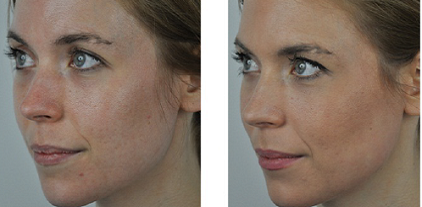
Abrstract
Background: Historically, the treatment of acne vulgaris without systemic intervention has been challenging due to its pathophysiology and the inflammatory nature of the disease. With the introduction of the SharpLight OmniMax, a multiple modality treatment platform, the improvement or resolution of acne vulgaris without systemic medication is now possible.
Another common outcome of acne vulgaris is the development of scarring, a condition that is also difficult to treat, due to its pathology and variability in scar morphology. With the breakthrough technology found in the SharpLight OmniMax system, the different chromophores associated with acne vulgaris and scarring can be addressed in the same treatment session. This is achieved through the use of the different lasers and light source wavelengths required to effectively treat both skin conditions.
Objective: To evaluate the effectiveness of the SharpLight OmniMax device at treating active acne vulgaris and the scarring secondary to acne vulgaris.
Methods: The SharpLight OmniMax device was used to treat 10 patients with scarring secondary to acne vulgaris, 5 of these also had active acne vulgaris. Only patients who represented clinically challenging cases of acne vulgaris and acne vulgaris scarring were chosen for inclusion in the study. Specifically, each patient had grade 2 or higher active acne vulgaris with papules and/or pustules. Treatment was performed with the SharpLight OmniMax outfitted with a specialized intense pulsed light (IPL) acne handpiece which included contact cooling and dynamic pulse control (DPC 415 nm handpiece). Patients were treated twice weekly.
All patients included in the scar treatment portion of the study had ice pick scars, and rolling scars that were erythematous. Each patient received 4-6 treatment sessions separated by 2-6 weeks. During each session, the SharpLight OmniMax Erbium YAG 7 x 7 hand piece was used. This resurfacing component of the SharpLight OmniMax is an Erbium YAG 2940 fractional laser which allows a specific tissue ablation that is associated with limited residual damage. By leaving intact skin in the treated area, post-treatment wound healing is accelerated, which leads to transient erythema, rapid healing and minimal downtime.
Results: 80% of the acne vulgaris patients subjectively reported satisfaction with their treatments. In the acne scarring group 100% of patients subjectively reported an improvement in the overall appearance and texture of their skin. Specifically there was an overall improvement in texture, tone, depth of scarring and colour. Objective review of before and after photographs also demonstrated an improvement in scar depth, texture and skin tone.
Conclusion: The use of the SharpLight OmniMax device is an effective method of treating both active acne vulgaris and its coincident scarring, while also improving post inflammatory erythema. Acne vulgaris is effectively treated with the SharpLight OmniMax and the DPC 415nm handpiece, while atrophy and textural irregularity can be treated using the Erbium YAG 2940 nm hand piece. As such this advanced platform provides many benefits including an increased efficacy, shorter treatment time, and cost savings to both the patient and physician when results are more rapidly delivered.
Introduction
Acne Vulgaris is an inflammatory disease of the pilosebaceous unit which affects up to 90% of people in their lifetime. It can occur at any age, but it is most commonly seen in adolescents. Acne vulgaris is a multifactorial condition and may be caused by a disorder of keratinization in the duct of the pilosebaceous unit, or an increase in sebum production. Additionally, hormonal effects on the sebaceous gland and the presence of Propionibacterium acnes (P. acnes) have been implicated in the condition. Although acne vulgaris is a benign inflammatory disorder it can cause significant scarring and detrimental psychological sequelae.
Traditional treatment of acne vulgaris generally includes topical medications like anti-inflammatory agents, antibiotics or vitamin A derivatives. For more inflammatory cases, systemic therapies like oral antibiotics, oral contraceptives, spironolactone and isotretinoin may be employed. Though effective, systemic therapy can have undesirable and significant side effects, while topical agents may produce irritation. Furthermore, several changes may occur that do not respond to systemic therapy like post inflammatory erythema and post inflammatory hyperpigmentation.
Because of these limitations, treatment of acne vulgaris and the subsequent scarring has been pursued by other means. In particular the use of multiple wavelengths of intense pulsed light (IPL) with various cut off filters has been used successfully as a treatment method.1,2 These light based methods are safe and effective, with only a minimal risk of side effects. Given these qualities, patients are increasingly seeking this sort of treatment and the SharpLight OmniMax system is designed to specifically meet that demand.
The SharpLight OmniMax system is a multi-modality platform that includes several types of light based treatments. One of these modalities is a DPC 415 nm handpiece, which is designed to treat P. acnes. This intense pulsed light (IPL) equipment also includes the proprietary dynamic pulse control (DPC) technology. Visible light in the blue and yellow range of wavelengths cause a photo destructive effect on the porphryrins produced by the P. acnes bacteria, which results in a decrease in active acne papules.
The SharpLight OmniMax system also includes an Erbium YAG 2940 nm fractionated laser that treats scarring through a limited tissue ablation. Permanent scarring is a common consequence of acne that can cause significant distress in patients. There are multiple types of scarring that occur including ice pick, round, rolling and box car scars. The treatment of said scarring has been historically difficult to manage often with unpredictable results. In the past, older laser systems had the negative effect of producing even more scarring. With the SharpLight OmniMax Erbium YAG 2940 nm fractionated laser, untreated areas are interspersed with the wounded tissue. Leaving intact skin serves as a focus through which a more rapid tissue healing can occur. In the treated areas, energy from the fractionated laser ablates the superficial epidermis, which in turn heats the surrounding dermis. Increased heat energy stimulates collagen production, collagen remodeling and an overall improvement in acne scars.
Patients and Methods
In this study 5 patients were treated for active acne vulgaris and acne scarring, while 5 patients were treated solely for acne scarring. The patient group with active acne vulgaris and scarring consisted of 5 females ranging in age from 23-30 years with skin types I-IV. The acne scarring group consisted of 4 females and one male, who ranged in age from 23-33 and also included skin types I-IV.
Treatments for acne vulgaris were performed with the SharpLight OmniMax DPC 415 nm acne handpiece that included advanced contact cooling. Each patient received 11-12 treatments at a frequency of twice weekly with machine parameters set at 7-15 J/cm2 fluence, 50-115 pulses, 30- 50 msec.
Acne scarring treatment was performed with the SharpLight OmniMax Erbium YAG 2940nm 7 x 7 hand piece. Each patient received four to six treatment sessions spaced two to six weeks apart with machine parameters set at 1.2 joules, 1.2-1.5 msec with 2-4 passes individualized according to patient presentation.
Patient Inclusion Criteria
To be recruited, acne vulgaris patients were required to exhibit active grade 2-4 acne with at least papules. Beyond this minimum requirement some patients also presented with pustules and cysts.
Acne scarring recruitment criteria consisted of clinical acne scarring signs including atrophic scars, ice pick scars, rolling scars and erythematous scars. All patients had subjective concerns about their scarring. Clinical examination revealed acne scarring on the cheeks, as well as, forehead, glabella, temples, and mandibles.
Patient Exclusion Criteria
Criteria for exclusion was tanning within a 6 week period, oral isotretinoin or acetretin within 12 months, a history of hypertrophic or keloid scarring and photosensitivity disorders or taking a systemic medication that would cause photosensitivity. Other exclusion criteria were melasma, malignant disease, pregnancy or nursing, endocrine disease, systemic lupus erythematosus or other collagen vascular disease, psoriasis vulgaris, hematologic coagulopathy, epidermolysis bullosa, pemphigus vulgaris, pemphigus folliaceous, dermatographism or any chronic or acute disease could affect clinical outcome. Patients with a history of oral herpes simplex were given valacyclovir as herpes simplex virus prophylaxis.
Prior to treatment with the SharpLight OmniMax, photographs were taken using standardized AP and lateral views. Similar photographs were taken at the conclusion of the study. Additionally, photographs were taken of all patients before and after each patient’s individual treatment sessions. In preparation for the study patients completed a patient personal data form, received a physical examination, and had a medical history recorded. The diagnosis was discussed with each patient and informed consent was obtained after a careful discussion of the benefits, possible risks of the treatment plan and procedures, as well as, alternative treatment options.
Treatment Protocol
During this study the SharpLight OmniMax device was used to deliver all treatments.
Acne vulgaris treatment protocol
Prior to treatment informed consent was obtained and the patients’ medical history with a physician was taken to confirm patient eligibility. Patient intake information was obtained and each patient’s written medical history was reviewed by a physician. Prior to each treatment, a patient assessment was conducted that included a review of medical history and a discussion regarding the previous treatment and response to treatment. Physical examination on the day of treatment evaluated the skin, the presence and number of acne papules and their distribution and the degree of involvement. If patients had any signs and /or symptoms of infection on the day of treatment including herpes simplex virus they were excluded from treatment that day and the infection was treated appropriately.
The skin was prepped with a chlorhexidine cleanser composed of 2 % chlorhexidine gluconate solution with 4% isopropyl alcohol. Topical anesthetic was not necessary as the procedure is generally well tolerated. Patients who had a history of facial herpes simplex virus were given antiviral prophylaxis immediately prior to treatment consisting of two, 2g doses of oral valacyclovir separated by 12 hours.
Before the main treatment sessions began, the SharpLight OmniMax with DPC 415 nm acne hand piece was used to perform a small test spot on the right cheek with parameters set at fluence of 10 J/cm2, 30 msec with 2 pulses. The clinical endpoint of this treatment was mild erythema.
All patients tolerated the test dose and treatment was extended to the entire face including affected areas on the neck if appropriate. Treatment parameters using the SharpLight OmniMax DPC 415 nm acne hand piece were 7-15 J/cm2 fluence, 30-50 msec pulse duration, 2-3 passes between 50-115 pulses. The determination of fluence, pulse duration and the number of passes were dictated by clinical presentation including the degree and distribution of inflammatory papules, skin type, and patient response to treatment. Treatments were performed twice a week for 5-6 weeks.
Following treatment patients returned to their usual skin care routine with instruction to use a clear SPF 30 spray or higher sunscreen as well as products that were gel based.
Acne scarring treatment protocol
Prior to treatment informed consent was obtained and a medical history was taken by Dr. Kellett to confirm patient eligibility. Patient intake information was documented and reviewed.
Assessment was performed on the day of treatment which included a physical examination to document presence and type of scars for each patient. During this examination clinical signs of exclusion were noted before each treatment, particularly the presence of herpetic vesicles or papules. The skin was prepped with a chlorhexidine cleanser composed of a 2 % chlorhexidine glucometer solution with 4% isopropyl alcohol. Topical anesthetic was not necessary as the procedure is generally well tolerated. Patients who had a history of facial herpes simplex virus were given antiviral prophylaxis consisting of two 2g doses of oral valacyclovir separated by 12 hours.
Prior to full face treatment, a test spot was performed using the SharpLight OmniMax Erbium YAG 2940 nm 7 x 7 hand piece at 1.2 joules and 1.2 msec. The clinical endpoint of the test spot was erythema with superficial obliteration of the stratum corneum with an absence of bleeding. As this was tolerated well in all patients, treatment was extended to the rest of the face including the cheeks, forehead, nose, chin and mandibular areas. Treatment parameters were 1.2 joules and between 1.2 and 1.5 msec and the number of passes was dictated by clinical response and patient tolerance as well as the depth, type and distribution of the scars. In general, more passes were performed on deeper and more atrophic areas.
Following treatment, sterile cold compresses were administered for patient comfort. Treatment sessions with the SharpLight OmniMax were scheduled 2 – 6 weeks apart. Patients were advised to apply Glaxal base three to four times in the first 24 hours. After 24 hours they were instructed to use a mild cleanser (Spectrogel) twice a day to wash then to apply Glaxal base three times per day. After 48 hours most patients were able to return to their normal skin care routines in addition to the regular use of sunscreen SPF 30 with UVB and UVA protection daily. After each treatment session follow-up calls were made to patients 24 – 48 hours post procedure to answer patients’ questions, assess response and obtain feedback.
Results
After each treatment with the SharpLight OmniMax and at each follow up visit, patients were evaluated on their subjective experience to the treatment regimen. Subjects were asked to subjectively grade their experience of the procedure and their results. The satisfaction scale was a four point scale consisting of:
1- Very satisfied, 2- satisfied, 3- somewhat satisfied , 4- not satisfied.
For the treatment of acne vulgaris and scarring, four of the five patients rated their experience as somewhat satisfied to very satisfied. Patients noted transient erythema after the treatment but there was no complaint of any adverse effects.
For the exclusive acne vulgaris scarring patients, all patients rated their experience with satisfaction levels of satisfied to very satisfied with most patients being very satisfied. All patients stated that they would do the treatment again. Furthermore, there was no complaint regarding adverse effects from any of the patients.
80% of patients were satisfied to very satisfied with the SharpLight OmniMax and 10% of patients were somewhat satisfied. Only 10% (i.e. only 1 patient) was not satisfied. Overall, 90% of patients rated their treatment experience as somewhat to very satisfied and most stated that they were happy with the results and would do the treatment again.
Objective rating was conducted by Dr. Kellett who reviewed the photographs of the patients and noted an improvement in active acne vulgaris in all patients as well as an improvement in acne scarring in all patients.
Details of Treatment Protocol
The SharpLight OmniMax has a wide variety of options, which can be used to individualize treatment parameters for each patient’s dermatologic needs. For example, the SharpLight OmniMax design includes adjustment of fluence, pulse duration, contact cooling and contact cooling on/off time in order to tailor the delivery of energy. Patients with active acne can be treated with an anti-inflammatory DPC 415 nm hand piece which is effective at treating both acne and post acne scarring.
In this study for acne vulgaris and acne scarring patients, the fluence using the DPC 415 nm hand piece varied from 7-15 J/cm2 with 30-50 msec. Contact cooling on the SharpLight OmniMax device was also used to maintain patient comfort while delivering an optimal light pulse in fluence, pulse duration and interpulse delay. This control protected the epidermis and provided a paradigmatic treatment efficacy.
The SharpLight OmniMax Erbium YAG 2940 nm 7 x 7 handpiece is ideal to resurface the skin of patients with acne scarring. The wide range of parameter options on this technology also allows for improved efficacy.
Recommendations
Pre protocol care
To maximize results with the SharpLight OmniMax, pretreatment preparation should include the avoidance of ultraviolet radiation, prophylaxis in appropriate patients for herpes simplex virus, and education regarding expectations.
Post protocol care
Acne vulgaris and acne scarring patients should be able to return to their usual skin care routine immediately after treatment with instruction given to selectively apply gel based products only, as well as, clear sunscreen sprays of SPF 30 or higher.
For the acne scarring patients, post treatment instructions for should include application of a bland moisturizer in the first 24 hours and then washing with a mild, liquid, non-foaming cleanser after 24 hours. Patients should be advised to avoid picking at, or any manipulation of, the face during the healing period. After this, sunscreen SPF 30 or higher should be used daily.
Conclusion
The SharpLight OmniMax successfully treated cases of acne vulgaris, as well as, acne scars that develop from the condition. Unlike single modality treatment platforms, the SharpLight OmniMax incorporates multiple modalities in one system, which enables patients to see better, faster results. Additionally, an improved efficiency is gained for the physician by reducing the time required for treatment, the investment required for equipment, and the physical clinic space needed to provide first rate services.
In this study patients were simultaneously treated for active acne, as well as, the coincident scarring from this inflammatory disease, while experiencing no adverse effects. Overall, 90% of patients rated their experience as somewhat to very satisfied and most stated that they were happy with the results and would do the treatment again.
Overall, the multiple modality regimen has several advantages over single modality treatment systems. One critical advantage is how heat penetrates the skin when multiple modalities are used. Combining these treatment methods allows for greater heat dispersion to the dermis, which in turn enhances collagen production and remodeling. Furthermore, patients and clinicians see faster results from the various treatments, which can be performed all at once, unlike single modality treatments that may be spread out over several office visits.
References
1. Babilas P, Schreml S, Szeimies RM, Landthaler M. Intense pulsed light (IPL): a review. Lasers Surg Med. 2010 Feb;42(2):93-104.
2. Barikbin B, Ayatollahi A, Younespour S, Hejazi S. Evaluation of Efficacy of Intense Pulsed Light (IPL) System in the Treatment of Facial Acne Vulgaris: Comparision of Different Pulse Durations; A Pilot Study. Journal of Lasers in Medical Sciences . Spring2011, Vol. 2 Issue 2, p67-72.
Dr Lisa Kellett is a Dermatologist certified in 1997 in both Canada and the United states. She is the founder and principal dermatologist at DLK On Avenue specializing in cosmetic dermatology and laser surgery. She graduated with Honours at University of Toronto with a degree in Medicine and went on to do an internship and a second year residency in Internal Medicine at the University of Western Ontario. She then completed a Dermatology residency at the University of Toronto. She is a fellow of the Royal College of Physicians and Surgeons of Canada, and a member of the Canadian Laser Aesthetic Surgery Society, the Toronto Dermatological Society and the College of Physicians and Surgeons of Ontario.
Dr. Kellett has extensive experience in the use of medical technology including the development of new technology and has been at the forefront of using cutting edge devices in Cosmetic and Laser Dermatology. Due to her innovation in the field of cosmetic dermatology, she has lectured widely about developments in laser surgery and has been a leader in the industry for over 15 years.
Dr. Kellett has been involved as a consulting dermatologist to laser companies to influence new product development. She has been widely featured in the media including print , radio, online and television such as Flare, Fashion , Elle , Globe and Mail, Toronto Star, National Post , Ottawa Citizen, Zoomer, Reader’s Digest, Canadian Living, Chatelaine, Huffington Post, Maclean’s , Now , Elevate, Todays Parent, Alive, Best Health, Glow, Global , CBC, CTV, City TV, Marilyn Denis show, e talk, E! Network, W5, Slice network, ET Canada, Canoe Network among others.
| ACNE SCAR |
Gender Age |
Treatment Area |
# of Tx | Type of Treatment |
Parameters of Treatment |
Patient Satisfaction |
Post treatment Response |
| #01SA | F 28 |
Face | 5 | Fractional | 7X7 msec 1.2 joules 1.2 2 passes allover 4 passes cheeks |
1 Very satisfied. |
2 day recovery |
| #02BB | F 23 |
Face | 4 | Fractional | 7X7 Msec 1.2 joules 1.2 4 passes |
1 Very satisfied |
3 day recovery |
| #03IK | M 28 |
Face | 6 | Fractional | 7X7 Msec 1.2-1.5 Joules 1.2 4 passes |
1 Very satisfied |
2 day recovery |
| #04KL | F 33 |
Face | 4 | Fractional | 7X7 Msec 1.5 Joules 1.2 4 passes |
2 Satisfied |
2 day recovery |
| #05AM | F 30 |
Face | 4 | Fractional | 7X7 Msec 1.2 Joules 1.2 3 passes |
1 Very satisfied |
2 day recovery |
| ACNE and ACNE SCAR |
Gender Age |
Treatment Area |
# of Tx | Type of Treatment |
Parameters of Treatment |
Cooling Temperature |
Patient Satisfaction |
Post Treatment Response |
| #01MA | F30 | Face | 11 | Acne filter 415 | 2-3 passes 50-115 pulses Fluence 10-14 msec 50 |
High | 1 Very satisfied |
Mild transient erythema |
| #02BB | F 23 |
Face | 12 | Acne filter 415 | 2 passes 63-82 pulses Fluence 10-15 msec 40 |
High | 1 Very satisfied |
Mild transient erythema |
| #03AM | F 30 |
Face | 12 | Acne filter 415 | 2 passes 53-90 pulses Fluence 10-14 msec 50 |
High | 1 Very satisfied |
Mild transient erythema |
| #04RS | F 23 |
Face | 12 | Acne filter 415 | 2 passes 70-90 pulses Fluence10-15 msec 40-50 |
High | 3 Somewhat satisfied |
Mild transient erythema |
| #05AW | F 28 |
Face | 12 | Acne filter 415 | 2 passes 60-90 passes Fluence 7-15 msec 30-40 |
High | 4 Not satisfied |
Mild erythema |
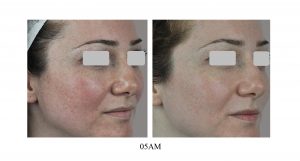
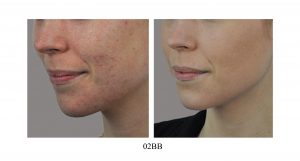
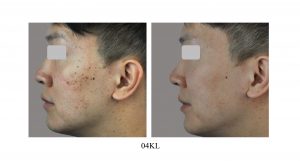
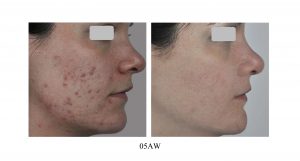
Dr. Lisa Kellett, M.D., F.R.C.P.(C), D.A.B.D.
Dermatologist, DLK on Avenue
108 Avenue Road, M5R 2H3
Toronto, Ontario, Canada
Tel. 416-440-2597 Fax. 416-923-2597
September 2012 April 2013





